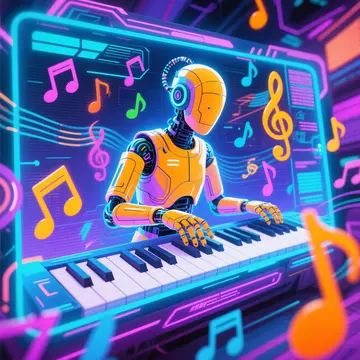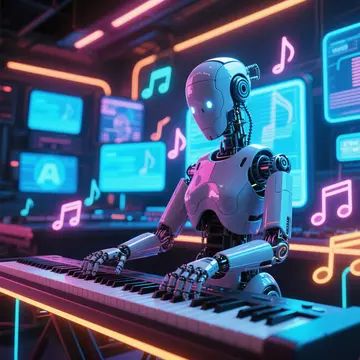Introduction: Can AI Really Generate Piano Sheet Music?
Absolutely. One of the most practical uses of AI in the music world is transcription—especially when it comes to piano. Whether you’re a composer, performer, or a music teacher, using an AI piano sheet music generator can save you hours of manual work. It can listen to a melody or audio file and convert it into readable piano sheet music in minutes.
For decades, musicians had to transcribe songs note-by-note, often by ear. Now, thanks to advanced machine learning models, AI tools can analyze audio and MIDI data, interpret pitch, timing, dynamics, and instantly render polished piano scores. Some can even generate harmonies, suggest chord progressions, and format your work for printing or publishing.
In this guide, we’ll explore how to generate piano sheet music using AI, the best tools available, and real use cases from musicians and educators. If you're looking for a fast, reliable way to create sheet music—AI may be your new favorite collaborator.

Why Use an AI Piano Sheet Music Generator?
AI is not just about speeding up the process—it’s about expanding musical possibilities. Here’s why more musicians are turning to AI for piano sheet music:
Time-Saving: Transcribing a 4-minute piece by hand can take hours. AI does it in seconds.
Beginner-Friendly: No need for advanced theory knowledge or notation skills.
Audio-to-Sheet Conversion: Play a melody on your piano, and the AI converts it into sheet music automatically.
Supports Learning: Great for teachers who want to quickly notate student compositions or break down songs for lessons.
Inspiration Tool: AI can suggest arrangements, harmonizations, and inversions that can spark new musical ideas.
Whether you're preparing for a recital, teaching young students, or composing digital scores, using an AI piano sheet music generator is a powerful asset.
Top AI Piano Sheet Music Generators You Can Use Today
Let’s dive into real tools that are already transforming the music industry. These AI platforms aren’t just theoretical—they’re live, functioning, and already being used by thousands of musicians.
Flat.io (with AI Integration)
Cloud-based score editor that now supports AI-assistance for melody generation and transcription.
Works with MIDI inputs and allows piano score formatting.
Collaborative tool perfect for classrooms and ensembles.
AIVA.ai
Originally designed to compose orchestral music, AIVA can export compositions in piano format with full sheet music.
Great for composing original piano pieces that are AI-assisted but editable.
Outputs MusicXML, MIDI, and PDF.
MuseScore + Audiveris OCR Plugin
MuseScore is a free notation editor. When paired with Audiveris, it can import audio or scanned scores and transcribe them into digital piano sheet music.
Great for converting handwritten notes or old books into digital formats.
Melody Scanner
Mobile and desktop app that can listen to your performance and convert it into sheet music in real time.
Especially popular for converting popular music and YouTube piano covers into readable notation.
Includes editing tools to tweak notes, tempo, and articulation.
Symphony AI (formerly ScoreCloud)
Sometimes called the “Google Translate for music,” it listens to what you play and writes it down instantly.
You play on a MIDI keyboard or sing, and the AI figures out the sheet music on the fly.
Works well for sketching ideas and exporting to MusicXML or PDF.
AnthemScore
AI-powered transcription software designed for piano and polyphonic instruments.
Takes audio recordings (MP3, WAV) and automatically detects notes and rhythms.
Highly customizable and detailed, with dynamic staff editing.
How to Generate Piano Sheet Music with AI: A Step-by-Step Guide
Let’s say you’ve composed a new melody on your piano or found a beautiful melody online that you’d like to transcribe. Here’s a typical workflow using AI tools:
Step 1: Choose Your AI Tool
Decide if you want to use a mobile app (Melody Scanner), a browser-based editor (Flat.io), or a full desktop suite (AnthemScore or MuseScore with plugins).
Step 2: Upload or Record Your Audio
Most tools accept WAV, MP3, or MIDI formats. Some even let you record directly using your laptop mic or MIDI controller.
Step 3: AI Transcribes the Music
The software processes pitch, timing, dynamics, and meter. It may take anywhere from 10 seconds to a few minutes, depending on complexity.
Step 4: Edit the Notation
Fine-tune the sheet music—correct note durations, add slurs, dynamics, or pedal markings as needed.
Step 5: Export the Sheet Music
Download your final piano sheet music as a PDF or MusicXML for printing or sharing with others.
Real-World Use Cases from Teachers, Students, and Composers
Music Teachers: Many educators use AI tools to instantly create sight-reading exercises or turn student improvisations into sheet music.
Film Composers: Composers who work with orchestration often use AIVA or MuseScore to convert MIDI sketches into polished piano parts.
YouTube Pianists: Creators use Melody Scanner to generate sheet music from their performances to sell or share with subscribers.
Choir Directors: Tools like Symphony AI help transcribe complex harmonies from rehearsal recordings.
In all these cases, AI is saving time, increasing accuracy, and empowering more musical output.
Pros and Cons of Using an AI Piano Sheet Music Generator
| Pros | Cons |
|---|---|
| Fast transcription | Occasional rhythm or timing errors |
| Works with real audio, not just MIDI | Requires editing for complex pieces |
| Beginner-friendly UI | Some tools have export limitations |
| Useful for both learning & composing | May miss subtle dynamic expressions |
Tips for Better Results
Use clean audio: Avoid background noise for better transcription accuracy.
Limit polyphony in early drafts: AI tools do better with simpler passages.
Play to a click or metronome: Keeps tempo consistent for cleaner transcription.
Pair AI with manual editing: Treat the AI output as a rough draft, not a final version.
Conclusion: Should You Use an AI Piano Sheet Music Generator?
If you value speed, flexibility, and creative efficiency, the answer is yes. The ability to create piano sheet music with AI is no longer futuristic—it’s a daily tool for educators, composers, and musicians around the world.
With options ranging from free to pro-level, you don’t need to be a tech expert or music theory wizard. You just need an idea and the willingness to experiment. Whether you’re preserving a melody, teaching a class, or composing your next big project, an AI piano sheet music generator can streamline your workflow and expand your musical reach.
FAQs
Can AI generate sheet music for any song?
Yes, though accuracy depends on the clarity of the audio and complexity of the arrangement. Tools like AnthemScore and Melody Scanner do well with piano solos and pop songs.
Is AI-generated sheet music accurate?
Mostly, yes. You may still need to fix occasional timing issues or articulation marks, especially with fast passages.
Can I export AI-generated sheet music to print?
Yes. Most tools export to PDF, MusicXML, or MIDI for printing or further editing.
Is it free to use AI piano sheet music generators?
Some tools like MuseScore and Flat.io offer free versions. Advanced features (e.g., batch exports, pro notation layouts) may require a subscription.
Can I use AI to create piano sheet music from YouTube songs?
Yes. Tools like Melody Scanner allow you to paste a YouTube link and generate sheet music from the video’s audio.
Learn more about AI MUSIC

